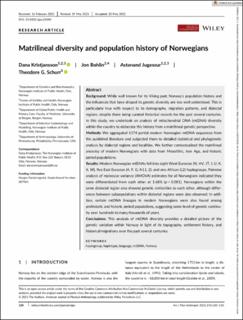Matrilineal diversity and population history of Norwegians
Journal article, Peer reviewed
Published version

Åpne
Permanent lenke
https://hdl.handle.net/11250/2768811Utgivelsesdato
2021Metadata
Vis full innførselSamlinger
Originalversjon
American Journal of Physical Anthropology. 2021, 176 (1), 120-133. 10.1002/ajpa.24345Sammendrag
Background: While well known for its Viking past, Norway's population history and the influences that have shaped its genetic diversity are less well understood. This is particularly true with respect to its demography, migration patterns, and dialectal regions, despite there being curated historical records for the past several centuries. In this study, we undertook an analysis of mitochondrial DNA (mtDNA) diversity within the country to elaborate this history from a matrilineal genetic perspective.
Methods: We aggregated 1174 partial modern Norwegian mtDNA sequences from the published literature and subjected them to detailed statistical and phylogenetic analysis by dialectal regions and localities. We further contextualized the matrilineal ancestry of modern Norwegians with data from Mesolithic, Iron Age, and historic period populations.
Results: Modern Norwegian mtDNAs fell into eight West Eurasian (N, HV, JT, I, U, K, X, W), five East Eurasian (A, F, G, N11, Z), and one African (L2) haplogroups. Pairwise analysis of molecular variance (AMOVA) estimates for all Norwegians indicated they were differentiated from each other at 1.68% (p < 0.001). Norwegians within the same dialectal region also showed genetic similarities to each other, although differences between subpopulations within dialectal regions were also observed. In addition, certain mtDNA lineages in modern Norwegians were also found among prehistoric and historic period populations, suggesting some level of genetic continuity over hundreds to many thousands of years.
Conclusions: This analysis of mtDNA diversity provides a detailed picture of the genetic variation within Norway in light of its topography, settlement history, and historical migrations over the past several centuries.
